
Meet my new mission in life: Horst Bandel’s Black Pumpernickel from Jeffrey Hamelman’s Bread. I made this for the first time over the weekend (yes, it took all weekend) and can verify reports that it is not a breeze. It wasn’t a disaster; I definitely have something edible, but it could be so much better. I’ve been bitten and I know it will keep after me until I get it right.
This is a heavy, dark, dense bread made from rye meal sourdough, soaked and cooked rye berries, cracked rye (which I substituted for unavailable rye chops), a small amount of high-gluten wheat flour, and an old bread soaker. It tastes fantastic. So what’s wrong with it? Two words: overhydrated and underbaked. Instead of being pleasantly moist like pumpernickel should be, mine could be called downright soggy.
About the overhydration: For my old bread, I used about a half a loaf of rye sourdough which had sat out until it was extremely hard and dry. So hard, in fact, that slicing it was not going to happen, so I put the whole thing in hot water and soaked it for the specified four hours. It soaked up so much water that after pouring off the excess, I couldn’t squeeze the bread out as directed; it disintegrated straight away and I had a mush about the consistency of mashed potatoes. I tried to press and drain in it a colander, but the water just did not want to part from that mush.
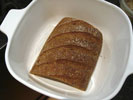
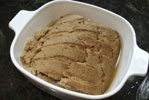
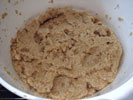
On top of that, I overcooked the rye berries.
Hamelman warns that possibly no additional water will be needed beyond what is contributed by the rye berry and old bread soakers, and I didn’t add a drop. But those soakers just started out too hydrated to begin with, so I ended up adding more flour to the dough. In the end it was still too wet to shape into a log, so I ended up just plopping the whole gooey mass into the pullman pan.
Of course the extra water and flour added additional mass to the dough, but did I think to scale it back so it wouldn’t bust out of the pan? No I did not. Doh. Actually it didn’t exactly bust out, because a pullman pan has a lid, but it wanted to. At the end of the 50-minute proof it was already touching the lid (which had been oiled and floured, thank goodness). By the end of the 12-hour bake (no, that’s not a typo) it took some doing to get the lid off, my nice diamond scoring was obliterated, and the crust looked like it was in need of a serious dose of antibiotic.
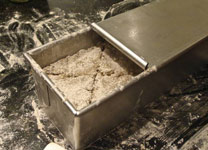
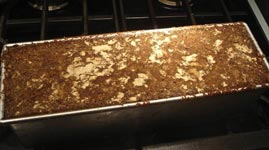

Now about the underbaking: The bread is supposed to bake for 12–16 hours in a receding oven, which gives the bread its rich color and sweet flavor. Because all ovens are different, each will have its own parameters for optimal temperature and time. I followed Hamelman’s suggestion for a starting point, which was to bake at 350F for an hour, turn the oven down to 275F for another hour, and then turn the oven off. At the end of 12 hours (total) the oven was pretty much cold. Next time I’ll start a bit higher, keep the oven on longer, and keep the baking stone in the oven for better heat retention; we’ll see how that works.
Wish me luck on my next attempt. When I get it closer to right, I’ll post more photos and a better description of the process. I’m not ever going to post the recipe proper, so if you’re thinking about trying this bread, just get the book. You should have it if you’re a bread baker, period. And before you make this pumpernickel, you need to read the charming story of how Hamelman learned it from the German minister Horst Bandel. So just get the book. The recipe is on page 222.
Been meaning to try this specific recipe or any pumpernickel that needs a long, slow baking time. There’s this recipe where the loaves are baked for 16 hours at 225… I wonder how well that would work.
I wish you luck for the next attempt, Susan.
Despite of what you’ve described about your pumpernickel, it really look good in your photographs.
Wow, that’s… intense. I’m impressed already.
That bread has been on my to do list since I read the Horst Bandel story in the book. The description of the smell when they open the oven in the morning captured me the first time. Well done for trying it.
I’ve been waiting to finish my brick oven before I try it as I figure that might be the trick for a long slow bake in a receding oven. I’ve been waiting a long time – it’ll be almost 2 years from breaking ground to current eta!
Have you considered using your snazzy new earth oven instead of your kitchen oven? Finish your bake, put the pumpernickel in and come back in the morning?
I’ve been meaning to try this bread, too. (This bread is the reason I bought a pullman pan!). Keep trying and let us know your progress. Someday, I’ll have the guts and time to make this bread, too…
Hey susan,
Wilkommen! You really are biting the bullet with the rye!
I tried this a while back, not as successfull as yours@!
Herr Supke, whom I just interviewed has a bread called hamster bread, that is a nice loaf, just haven’t managed to get it right yet!
Nils is a good source for these tricky breads, but I am getting the hang of it finally!
Feed the starter and it will feed you!
So, apparently in order to bake this bread correctly you need a good old-fashioned Russian- or German-style room-sized wood stove. I have to say that I love pumpernickel, but this recipe would probably make me cry. You are a strong woman!
Oh, this IS disheartening, Susan! Black bread like this has been on my mind for a while (I adore it) and I’ve been contemplating making it (if I’d gotten it together to make bread for Jude’s wholegrain BBD, that was what I had been planning to try).
But if YOU’RE having difficulty with it, what are my chances at success?!
Good luck with your next attempt. I know you can do it! And then maybe, just maybe, I’ll have the courage to try too.
This attempt is impressive, and is something that I will eventually try my hand at, but first I’ve got to get the book…yes, I don’t have it yet! Why? I haven’t a clue because everything I hear about it is great news.
Thanks for your post, Susan. I love how you always push the limits and then some. It encourages others to do the same. 🙂
I’ve not tried this type of bread before. I’m sure you’ll nail it with your next attempt. I’ve been very inspired with yr blog and all your bakes.
Oh good heavens . . . you mean this is the bread I’ve been longing to find a recipe for all these years and it’s in a book I have. Susan I love you!
This looks like one tough cookie!!
Obviously,
1. I can’t read or
2. I was blind the day I passed over the story page on this bread.
That is the essence of baking breads with and for others! Thanks for the knock on the head!
Susan,
I was just thinking that I wish you would post something about 100% rye as I have been trying these sorts of breads lately but I find that the books leave a lot to be desired in terms of direction. Have you tried ABAA’s Dutch Regale Korn Bread? I’ve had the best luck (if you can call it that) with that particular bread.
Wow! That is bold! I would not even consider trying to bake this bread. I am sorry to read that the result was not that good. But every (home) baker has had his ups and downs, so better luck next time.
Like I mentioned, there are a few formulas in the ‘Bread’ book that I find too intimidating(like this one) to make. Maybe some day. Good luck next time!
Well, I’ve been eating and enjoying this loaf all week, despite the shortcomings. I have to remember to save a bit to use in the next one. I really hope I didn’t scare anyone away from this. For me, part of the fun is playing around with something to make it better; give me a challenging loaf and I’m a happy camper.
Hi Susan, I haven’t tried this bread yet but wanted to very much. Your version looks very much like my experiences with making Vollkornbrot, underbaked and over hydrated. Earlier this year when attending the bread course at KA we made Vollkornbrot, I was surprised how dry and stiff the sourdough final build was and the final dough too. The bread was baked off in a single rack gas oven for a brief hour and a half! We let it “cure” overnight wrapped in linen and sliced into it the next day at lunch. Not surprisingly it was perfect. I have had many disappointments with the Voll since that time and have thought long and hard about what I have done wrong. I keep on coming back to three things: hydration, baking temp., and baking time. I think that correct hydration is the key and the other two variables will sort themselves out after the hydration percentage is worked out. Jeffrey has been making Vollkornbrot for a long time, he knows his oven’s heat curve really well. He has really nailed the baking time: just long enough. In the formulas for both Voll and HB’s Pumpershnickity I think he mentions to roll the loaves out in “log fashion”, in order to do that with 100% (or close to it) rye bread you need some cohesiveness, ie, lower hydration!
I hope that this helps a little.
You haven’t scared me away (very much) but it’s given me pause. One thing that I notice about your bread is that it isn’t nearly as dark as the black bread we buy. I’m guessing they use molasses to make it so dark – it really is almost black rather than the darkish brown of your bread.
(Of course, the real reason I haven’t tried making this is because I’m lazy…)
I’m sorry to hear that your first loaf of black pumpernickel was overhydrated and underbaked, but better luck next time. (At least it tasted fantastic, right?) There’s no greater satisfaction than to master a challenging loaf!
Hi Susan, Did you ever revisit this recipe? Horst is sitting in the oven at the moment. I had exactly the same thing with the bread soaker. The other recipes tell you how much water to use but this one doesn’t, so do you think the solution might be to use less water to start with for the soaker, and then top it up if it takes it all in and still feels dry? So far HB BP has had 5 hours in the oven. An electric fan oven. If I turn it off it will go cold in about an hour or so. So I keep turning it down and looking at it and wondering……. guess I won’t know what the result is till tomorrow.
I’ve made this recipe about 6 times with a roughly 50% success rate. Generally if I follow the recipe with no adaptation, the resultant dough is way too moist, so I am experimenting with maintaining the flour and reducing the water. 50% less water is too much of a reduction. Next time I attempt it I will go for a 25% water reduction. Such a delicious end result when you do get it right, that it’s worth the experimentation and botched results.
For example, take a look at Occupational Health & Safety You can pay per
lead or pay for a sure period of time to be posted.
f789d779e5d72ade7998b4b0387cd4d5